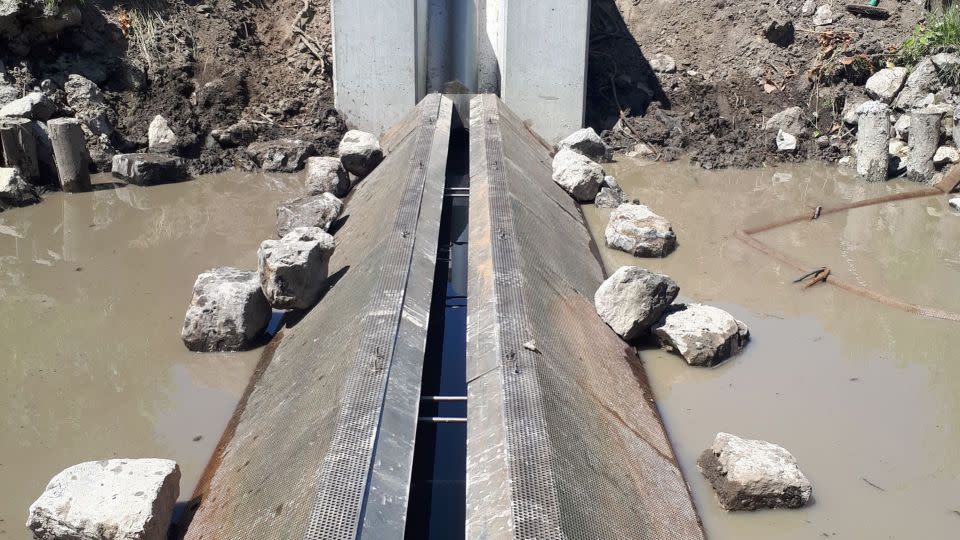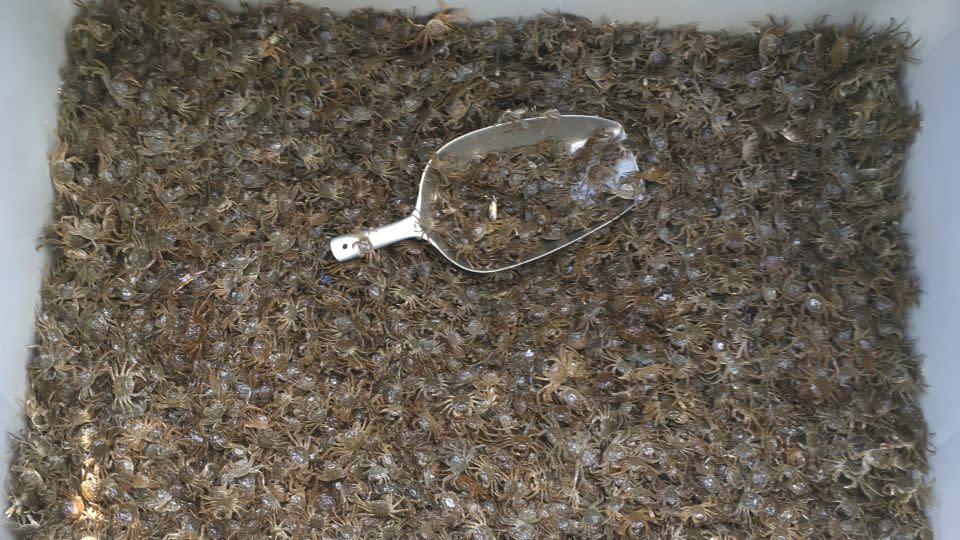Editor’s Note: Call to Earth is a CNN editorial series reporting on the environmental challenges facing our planet, along with the solutions. Rolex’s Perpetual Planet initiative partners with CNN to raise awareness and education around important sustainability issues and inspire positive action.
Named for the dense mats of hair on their front claws, Chinese mitten crabs are intimidating creatures. Their dark brown bodies can grow up to three inches, and with their claws extended, they can grow up to 10 inches – about the size of a dinner plate.
Classified as one of the world’s 100 worst invasive alien species, the crabs are virtually indestructible: they feed on almost anything, can survive on land as well as in fresh and salt water, and they can reproduce quickly – with females between 250,000 and 1 million eggs per spawning.
They were first seen in Europe over a century ago, in a river near Bremen, Germany. They probably made the journey from their native Asia in the ballast water of ships. Since then, populations have exploded across the continent. Today, 18 of the 27 member states of the European Union have developed populations of the crab and the crab is listed as an invasive alien species of concern. erosion of dikes and banks due to digging.
Scientists across the continent are looking for ways to reduce the mitten crab population and thereby protect the native ecosystems destroyed by the invasive species. In 2023 they united under an EU-funded project called ‘Clancy’.
So far, the most successful strategy has been a trap, developed by the University of Antwerp and the Flemish Environment Agency in Belgium. Since 2018, three such traps have been installed in the country, catching an estimated three million crabs, said Jonas Schoelynck, professor of aquatic ecology at the University of Antwerp. A metal channel is installed across a river, into which the crabs fall as they walk along the riverbed. Because they cannot swim out like other aquatic species, they are forced to crawl along pipes that lead to cages on either bank, where they can be collected in their masses and discarded.
Another trap of the same design, independent of the EU project, was installed in Britain last year, and the group plans to roll out more in Belgium, Germany, France and Sweden in the coming years.

Crabs invading cities
The traps will target areas through which large numbers of crabs migrate. In the fall, the adult crabs migrate from fresh water to the sea to release their eggs, and in the spring, the young crabs travel from the sea up the rivers. They travel astonishing distances, up to six miles a day, Schoelynck says, adding that some have been sighted more than a thousand miles inland.
It is during these months-long periods that they are most visible. They gather around lock gates or move over land to avoid weirs and other obstacles.
“Sometimes they take a wrong turn and end up in the city center,” says Schoelynck, who remembers the hundreds of crabs crawling through the streets of Lier, a small Belgian town at the confluence of two rivers. He has even heard testimonies of them climbing up walls and sneaking into the damp bathrooms of people’s homes.
The crabs thrive in European environments for several reasons, he explains. Like most invasive species, they have no natural predators, are opportunistic feeders and are very resilient. But climate change could also play a role, as warmer waters could help the crabs feel more at home.
There is also the strong genetic diversity of the species. Schoelynck says scientists in Europe have reported crabs that are a hybrid of both the Chinese and Japanese species of mitten crab. “If you become a hybrid, you are suddenly stronger than your competitors and you can survive the challenges better. This, together with better water quality (in recent decades), along with perhaps climate change, (contributes) to the new boom we see taking place today,” he says.
Damage control
The EU estimates that invasive alien species cost its members €12 billion ($13 billion) a year in economic damage, and its 2030 Biodiversity Strategy commits to managing these species and preventing their spread.
Scientists believe the traps offer a cost-effective solution. “The system is very nice, very simple,” says Björn Suckow, a scientist at the Alfred Wegener Institute, based in Germany, and involved in the Clancy project. He explains that if they were rolled out on a larger scale, they would be placed in small, accessible tributaries rather than deep, wide rivers, and that during the busy migration season the boxes on either side of the bank would need to be checked regularly and emptied to prevent a build-up of scratches.
Other catching methods, such as using nets, are more labor-intensive and expensive, Schoelynck says. “On a good day in Belgium you might catch 80 to 100 crabs per day (with a net), while with the new trap you catch 8,000 to 10,000 crabs per day.”
There is also much less bycatch, he adds. “When you use nets or traps (a tubular net with hoops), you catch fish, even endangered fish that you are trying to protect. With this trap, no side effects have been observed on aquatic organisms so far.”


A human ending?
One of the main unanswered questions is what to do with the crabs once they are collected. Suckow explains that different countries in the EU have different animal welfare rules. In Germany, scientists are only allowed to kill crabs by cooking them or using electric current. While in Belgium they freeze the crabs in buckets.
“We expect the project will provide feedback on (the most) humane way to kill them,” Suckow adds, as well as potential uses for the dead crabs.
While mitten crabs are a seasonal delicacy in China, Schoelynck says they contain little meat and are therefore not popular in the European market. He adds that many of the crabs caught in the traps will be juveniles, while the crabs eaten in China are the larger adults. However, the crabs collected in one of the Belgian traps are sent to a local zoo to be used as animal feed, he says.
The scientists acknowledge it is a work in progress, but they hope the coordinated European effort will help gather knowledge and data about the invasive species and its impacts, and help shape an international strategy for controlling the population.
“If we know where the problem is, how big it is and how these populations are connected, we can pinpoint certain locations on the continent,” says Schoelynck. “We need coordinated action to help each other because there are no political boundaries for these animals.”
Sign up for CNN’s Wonder Theory science newsletter. Explore the universe with news about fascinating discoveries, scientific developments and more.
For more CNN news and newsletters, create an account at CNN.com